Pipes on pipes and batteries: the main types and features of
In this article we will talk about what are the decorative lining on the pipes of heating and batteries, what types they are on the market, and how to apply them for the purpose.
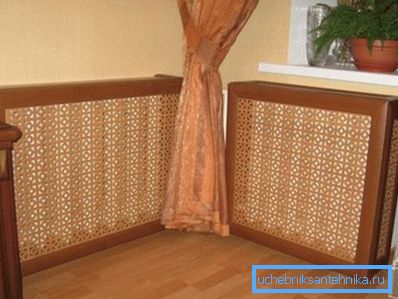
Reasons for using linings
When carrying out major repairs in an apartment or in a country house, the first thing to do is to replace heating pipes and radiators (also learn how to decorate the pipe and radiator in the apartment).
In place of old shabby “harmonicas”, new bimetallic or aluminum batteries are installed, and instead of shabby steel pipes, neat metal-plastic or polypropylene analogs are installed. But, despite the modern attractive appearance of new heating systems, they can not always fit into the interior of the dwelling.
It is in this case that a decorative overlay for pipes is used, which makes plumbing communications less noticeable or more attractive. Consider the main types of linings and determine the features of their operation.
Rosettes - a great solution for connecting pipes and floor
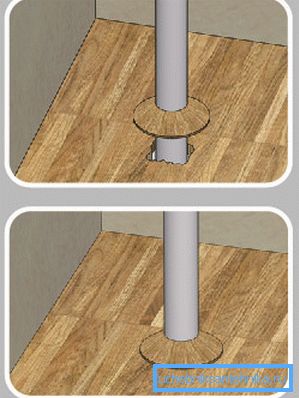
Laying any floor covering, including floorboard, laminate, linoleum or carpet, you are faced with the problem of the gap. At the site of junction of the coating and the pipe there is guaranteed to be a gap, which, as it were, does not interfere, but it does not look the best.
When laying laminate, a special gap of up to 10 mm is necessary, as it is intended to compensate for thermal expansion. Therefore, in this case, the gap can be closed only with a special device that will hide the cosmetic defect without compromising the functionality of the floor covering.
The rosette, a special plastic ring that is put on the pipe and inserted into the slot, will become the optimal and universal solution. The plastic ring is chosen according to the diameter of the pipes, since if the diameter of the rosette is smaller than necessary, it simply will not snap into place.

Among the advantages of using rosettes are the following qualities:
- universality of operation, as the device can be used with different types of floor coverings;
- a variety of colors and textures that mimic the surface of wood;
- a variety of sizes and, as a result, the possibility of selecting a device for most diameters of heating pipes;
- reasonable price, as the plastic itself is inexpensive;
- easy installation;
- aesthetic appeal.
However, there is one major drawback - such linings are not strong enough and with long-term use are prone to cracking.
Decorative boxes for heating pipes

Another type of overlays are decorative boxes, which are installed on the pipeline.
On the market are metal and plastic modifications. Both options are characterized by a number of advantages and distinctive properties that should be considered when choosing.
Important: Decorative boxes are available in sizes larger than the diameter of the pipeline, so from one, up to several pipes can be placed in one such device.
Structurally, decorative boxes resemble cable channels, but there is one difference. Since the coolant is transported through the pipeline, the front and side walls of the structure are perforated.
This is done so that heated air is released into the environment without heating plastic or metal walls.
Installation of such boxes is carried out by hanging on the pipe without fixing or by mounting on screws that are fixed in the wall. Installation of the box can be performed both with the pipeline already in use and at the design stage.
Decorative boxes for heating radiators
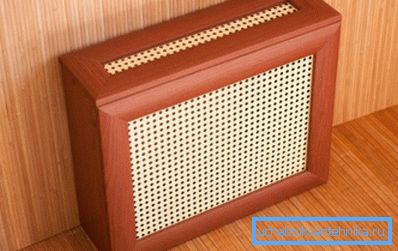
The decorating instruction for the heating pipe would be incomplete without finishing the batteries. Modern radiators themselves look good, but with special trim we will look much better.
Special trim with the ability to install on the radiator used at all times. Moreover, the design of these products has changed in accordance with the fashion that is relevant for a particular time.
Today, the radiator box can be purchased with pipe holders or separately. Structurally, the product resembles a rigid frame with a perforated front and top surface.
Sometimes, instead of a perforated surface, a metal mesh with an average cell size is used. This solution fits perfectly into most modern interiors.
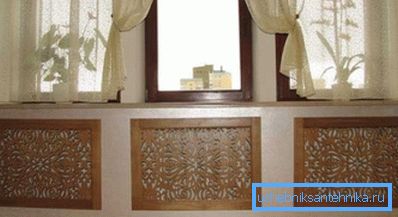
Mounting of the casing is carried out by means of usual hanging on the battery or by means of fasteners to the wall.
Important: There is a widespread opinion that various stoppers prevents the transfer of heat from the coolant to the external environment. In fact, high-quality decoration elements of heating systems have practically no effect on the efficiency of heating.
So, we have considered the main types of devices that allow hiding one or another part of the heating system without compromising the efficiency of heating. Now it remains to determine how to make the lining with your own hands.
We decorate pipes and batteries ourselves
We list the available methods of decorating elements of heating systems.
- The easiest way is to wall the entire pipeline into the wall.. In this case, no lining will be required at all, and the flooring can be laid without any problems.
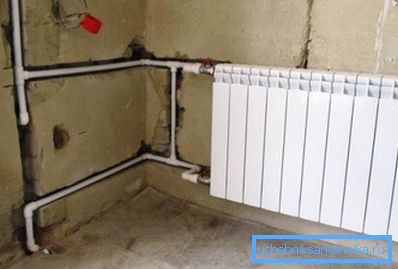
This technology is used in the construction of new buildings and may well be carried out during the overhaul in an ordinary apartment or house.
The only thing that needs to be taken into account is that only the best quality pipes can be laid into the plaster or in the screed, which over time will not become unusable and will not let flow. The best option is polypropylene, which is assembled into a single system by welding the joints.
- Unsightly pipes in the room can be wrapped with a rope or fabric fragments, as shown in the photo.

But you need to understand that such a solution is optimal only if the interior of the room contains similar decorative elements.
Important: Textile design of pipes is heat insulation, and therefore be prepared for the fact that the room after such finishing will be a little cooler than originally.
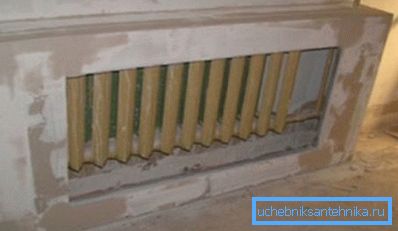
- Another good way to hide unprecedented communications is to construct a box in the form of a plasterboard construction.
- During the construction of such a box, a frame is mounted along the entire wall from the window sill line to the floor.
- Thin sheets of drywall are hung on the installed frame.
- At the level of heating radiators, openings are cut into which a decorative grid can later be installed.
- The finished box can be painted or wallpaper overlapped to the walls.
Conclusion
Now you know what the lining on the pipes and heating batteries are. In addition, we reviewed the features of installation and operation of the most relevant and popular devices on the market (learn here how to close the pipes with drywall).
If you have any questions, you can find more useful information by watching the video in this article.